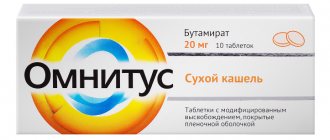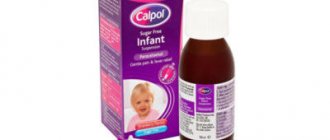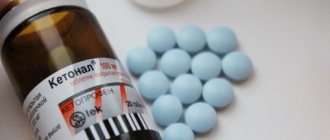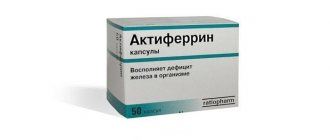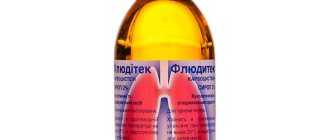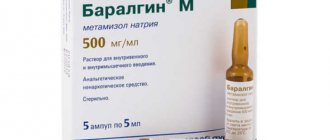MINISTRY OF HEALTH OF THE RUSSIAN FEDERATION INSTRUCTIONS for the use of the drug for medical use Thrombo ACC®
Registration number:
P N013722/01
Trade name:
Thrombo ACC®
Group name:
acetylsalicylic acid
Dosage form:
enteric tablets, film-coated
Description:
Round, biconvex tablets, white, film-coated.
The surface of the tablet is smooth or slightly rough, shiny. Pharmacotherapeutic group:
antiplatelet agent.
ATX code:
B01AC06
Release form and composition of the drug
In accordance with the instructions for use, "TromboASS" is an Austrian pharmaceutical drug. The tablets contain acetylsalicylic acid, commonly known as Aspirin, as an active component. True, unlike the classic medicine with antipyretic and analgesic properties, this ingredient is contained in a much smaller dosage, which provides a slightly different (antiplatelet) effect.
Thrombo ACC tablets contain 50 or 100 milligrams of the active ingredient. Both options involve a small amount of acetylsalicylic acid, so this drug can only be used to thin the blood, and not to relieve pain or reduce temperature. Of course, if you wish, you can also drink ThromboASS, but to do this you will have to immediately take as many as five tablets, which in dosage will be equivalent to one pill of regular Aspirin, which is impractical and unprofitable.
But it is quite possible to replace the drug in question with regular Aspirin, because the active substance is the same. But in this case, the tablet will have to be divided into quarters to obtain an amount of acetylsalicylic acid equal to 50 or 100 milligrams.
The auxiliary ingredients of the drug are microcrystalline cellulose along with lactose monohydrate, silicon dioxide and potato starch. The shell consists of components in the form of talc, triacetin, methacrylic acid copolymer and ethyl acrylate. The pills themselves of both dosages are painted white; they have a biconvex round shape combined with a shiny smooth or slightly rough surface.
Thrombo ACC: instructions for use
| pharmachologic effect | Acetylsalicylic acid, the active ingredient in Thrombo ACC tablets, reduces the ability of platelets to stick together and form blood clots. The drug has this effect because it inhibits the synthesis of thromboxane A2 in platelets. This property of aspirin is called antiaggregation action. It is used to prevent myocardial infarction, ischemic stroke and complications of varicose veins. Acetylsalicylic acid also has anti-inflammatory, antipyretic and analgesic effects. To do this, it must be taken in dosages higher than those contained in Trombo ACC tablets. |
| Pharmacokinetics | After oral administration, acetylsalicylic acid is quickly absorbed into the blood from the gastrointestinal tract. Both the liver and kidneys are involved in removing it from the body. In patients whose kidneys are functioning normally, 80-100% of a single dose of aspirin taken will be eliminated from the body within 24-72 hours. The manufacturer of Trombo ACC tablets claims that their special enteric coating reduces irritation to the gastric mucosa. But this claim is not supported by independent research. |
| Indications for use | Prevention of myocardial infarction and ischemic stroke, if there have not yet been cardiovascular “events”, but there are risk factors - diabetes, poor blood cholesterol, hypertension, obesity, smoking, old age. Prevention of recurrent heart attack and stroke. Prevention of ischemic stroke in people who have suffered a TIA (ministroke). Prevention of deep vein thrombosis and thromboembolism of the pulmonary artery and its branches. Angina pectoris stable and unstable. Read the detailed article “Aspirin for the prevention of thrombosis, heart attack and stroke” to find out whether you need to take Thrombo ACC daily or not. |
| Contraindications | Stomach and duodenal ulcers. Previous hemorrhagic stroke. Hypersensitivity, allergy to aspirin. Bronchial asthma, especially if taking aspirin is known to worsen its course. Severe renal failure (creatinine clearance less than 30 ml/min). Serious liver failure (class B or higher on the Child-Pugh scale). Chronic heart failure III-IV FC. Lactose intolerance, lactase deficiency and glucose-galactose malabsorption. Children and adolescents - up to 18 years. You cannot take acetylsalicylic acid simultaneously with the drug methotrexate at a dose of 15 mg per week or more. |
| special instructions | If a patient has gout or high levels of uric acid in the blood, then taking Thrombo ACC or other aspirin tablets may make things worse. If a patient has uncontrolled hypertension, prescribing aspirin may increase the risk of hemorrhagic stroke. If you are planning surgery, tell the surgeon in advance that you are taking aspirin. Most likely, you will need to stop taking it several days before surgery. Together with any other blood thinning medications, aspirin can only be taken as prescribed by a doctor, but not on your own initiative. |
| Dosage | Thrombo ACC is available in tablets containing 50 or 100 mg of aspirin (acetylsalicylic acid). These tablets are taken 1 piece per day. The appropriate dosage is determined by the doctor. For the prevention of deep vein thrombosis and pulmonary embolism, aspirin is prescribed in a dosage higher than for the prevention of heart attack and stroke - 100-200 mg per day. The drug Thrombo ACC is intended for long-term use. As a rule, it is prescribed for life unless there are serious side effects. Take at the same time every day, before meals, with plenty of liquid. It is not recommended to take on an empty stomach. |
| Side effects | Digestive system - nausea, heartburn, vomiting, abdominal pain. Rarely, aspirin causes gastrointestinal bleeding or gastric and duodenal ulcers. Deterioration in the results of blood tests for liver tests. Central nervous system - dizziness, hearing loss, tinnitus. Increased frequency of bleeding during surgical operations, hematomas, nosebleeds, bleeding gums, bleeding from the genitourinary tract. Allergic reactions: skin rash, itching, urticaria, Quincke's edema, swelling of the nasal mucosa, rhinitis, bronchospasm. As a rule, the drug Thrombo ACC is well tolerated by patients. The side effects listed above are not common. |
| Pregnancy and breastfeeding | The drug is contraindicated in the first and third trimesters of pregnancy. In the second trimester of pregnancy, it is used with caution - only with a strict doctor’s assessment of the risk and possible benefits for the mother and fetus, preferably in doses not exceeding 150 mg / day and for a short time. If a nursing mother is treated with aspirin, part of the dose taken is excreted in breast milk. Read more in the article “Aspirin during pregnancy and breastfeeding“. |
| Interaction with other drugs | Thrombo ACC and other acetylsalicylic acid preparations can interact negatively with many medications. Tell your doctor about all the medications, supplements, and herbs you take before you are prescribed aspirin. It is not recommended to combine aspirin with ibuprofen and other non-steroidal anti-inflammatory drugs. Aspirin enhances the effect of methotrexate, digoxin, insulin and drugs that lower blood sugar. Weakens the effect of many tablets for blood pressure and gout. You can take Thrombo ACC and other blood thinning medications together, but this increases the risk of bleeding and hemorrhagic stroke. Discuss with your doctor. |
| Overdose | Overdose can have serious consequences, especially for children and older people. Symptoms: dizziness, tinnitus, hearing loss, increased sweating, nausea and vomiting, headache, confusion, rapid shallow breathing, hyperventilation. Urgent hospitalization is required. In the hospital's intensive care unit, doctors will begin detoxification measures. Gastric lavage and taking activated charcoal can be done at home before the emergency team arrives. |
| Release form | Tablets are white, round, biconvex, with a shiny, smooth or slightly rough surface. Covered with an enteric film coating. They cannot be divided or chewed, but must be swallowed whole. |
| Storage conditions and periods | The package of Trombo ACC tablets should be stored out of the reach of children, in a dry place, protected from light, at a temperature not exceeding 25°C. Shelf life: 3 years. |
| Compound | Active ingredient: acetylsalicylic acid (aspirin) 50 or 100 mg. Excipients: lactose monohydrate, microcrystalline cellulose, colloidal silicon dioxide, potato starch. Shell composition: talc, triacetin, copolymer of methacrylic acid and ethyl acrylate (1:1) Eudragit L. |
Therapeutic effect of the drug"
As the instructions for use indicate, "ThromboASS" can show antiplatelet properties, which consist in reducing the adhesion of red blood cells and platelets. Moreover, the adhesion of formed blood elements to each other and to the walls of blood vessels decreases. Thanks to this, the blood turns out to be more fluid, not so viscous, it is much lighter, and at the same time it circulates better, without stagnating or creating blockages.
In accordance with the instructions for "ThromboASS", its antiplatelet effect also neutralizes the formation of blood clots in various vessels, which prevents the development of various serious conditions that are caused by blockage (we are talking about heart attacks, strokes, thrombosis, and so on). Acetylsalicylic acid, which is part of the drug in question as an active component, is currently considered one of the most commonly used antiplatelet agents in medicine.
The fact is that its antiplatelet property consists of a number of different mechanisms. For example, this substance affects the work of various enzymes, enhancing the production of some elements and suppressing other components. In addition, acetylsalicylic acid also produces a fibrinolytic effect, which consists in dissolving already formed blood clots and dismembering red blood cells that have managed to stick together.
The active ingredient of Thrombo ACC tablets, among other things, reduces the concentration of blood clotting factors, which also reduces the risk of blood clots. To stimulate the fibrinolytic effect, this substance is taken in low dosages of 75 milligrams per day. The antiplatelet effect persists for one week after a single use of ThromboASS. The described property of acetylsalicylic acid is used for the prevention and treatment of heart attacks, coronary heart disease, complications of varicose veins and other pathologies that are dangerous due to the formation of blood clots. Next, let’s find out what the main purpose of the pharmaceutical product in question is.
pharmachologic effect
Pharmacodynamics
Acetylsalicylic acid (ASA) is an ester of salicylic acid and belongs to the group of non-steroidal anti-inflammatory drugs (NSAIDs). The mechanism of action is based on irreversible inhibition of the enzyme cyclooxygenase (COX-1), as a result of which the synthesis of prostaglandins, prostacyclins and thromboxane is blocked. Reduces platelet aggregation, adhesion and thrombus formation by suppressing the synthesis of thromboxane A2 in platelets. The antiplatelet effect is most pronounced in platelets, since they are unable to re-synthesize cyclooxygenase. The antiplatelet effect develops after the use of small doses of the drug and persists for 7 days after a single dose.
These properties of ASA are used in the prevention and treatment of myocardial infarction, coronary heart disease, and complications of varicose veins.
Increases the fibrinolytic activity of blood plasma and reduces the concentration of vitamin K-dependent coagulation factors (II, VII, IX, X). ASA also has anti-inflammatory, antipyretic and analgesic effects.
Pharmacokinetics
Absorption
After oral administration, ASA is quickly and completely absorbed from the gastrointestinal tract (GIT). Thrombo ACC® tablets are enteric-coated, which reduces the direct irritant effect of ASA on the gastric mucosa.
The maximum concentration of acetylsalicylic acid in the blood plasma (Cmax) is reached approximately 2-7 hours after taking the tablets, thus, the absorption of ASA in the form of enteric-soluble film-coated tablets is slowed down compared to conventional tablets (without enteric coating).
When taken simultaneously with food, a slowdown in the absorption of ASA is observed without affecting the degree of absorption. The lower rate of absorption of enteric-coated ASA tablets does not affect the exposure of ASA in the blood plasma and its ability to inhibit platelet aggregation during long-term therapy with low doses of the drug. However, to ensure maximum stability of ASA tablets in the stomach, it is recommended to take the drug 30 minutes before meals with plenty of liquid (see section “Dosage and Administration”).
Metabolism
ASA is partially metabolized during absorption. During and after absorption, ASA is converted to the main metabolite, salicylic acid, which is metabolized mainly in the liver under the influence of liver enzymes to form salicyrulic acid, phenolic salicylic acid glucuronide, salicyl glucuronide and gentisuric acid.
In women, the metabolic process is slower (less enzyme activity in the blood serum).
Distribution
ASA and salicylic acid are highly bound to plasma proteins (from 49 to 70% for ASA; from 66 to 98% for salicylic acid, respectively, depending on the dose) and are quickly distributed in the body. After oral administration of ASA, salicylic acid crosses the placenta and is excreted in breast milk.
Removal
The elimination of salicylic acid is dose-dependent, since its metabolism is limited by the capabilities of the enzymatic system. The half-life ranges from 2-3 hours when using ASA in low doses and up to 15 hours when using the drug in high doses (usual doses of acetylsalicylic acid as an analgesic). Salicylic acid and its metabolites are excreted by the kidneys.
Unlike other salicylates, with repeated administration of the drug, non-hydrolyzed ASA does not accumulate in the blood serum.
In patients with normal renal function, 80-100% of a single dose of the drug is excreted by the kidneys within 24-72 hours.
Indications
According to the instructions for use, “ThromboASS” is prescribed to patients for use in a number of the following cases:
- Prophylaxis of acute primary myocardial infarction in individuals who are at high risk of developing it (for example, those with diabetes, high blood pressure, obesity, high cholesterol, as well as smokers and elderly people over the age of sixty-five).
- Implementation of prevention of secondary myocardial infarction after a previous one.
- For stable and unstable angina (as part of complex treatment).
- What else is Trombo ACC prescribed for? It is indicated for the prevention of stroke in people who suffer from transient cerebrovascular accident.
- Prevention of thromboembolism after surgery and manipulations performed on blood vessels (for example, coronary artery bypass grafting, carotid endarterectomy, angioplasty, stenting, and so on).
- To prevent problems with cerebral circulation.
- Prophylaxis of deep vein thrombosis, thromboembolism of the pulmonary artery, as well as its branches.
Instructions: How should I take this medicine?
According to the instructions for use, TromboASS should be drunk immediately before meals with a large volume of water (at least one glass of 200 milliliters is required). It should be remembered that in no case should you use this medication on an empty stomach, because this can provoke irritation with abdominal pain.
You must eat immediately after taking the medicine. Moreover, the word “eat” does not mean a whole set meal, but the consumption of a small amount of food that should fill the stomach. For example, after taking the ThromboASS tablet, it is enough to eat a couple of bananas or one sandwich, a small amount of porridge, salad, and so on. This will be quite enough to prevent the irritating effects of the drug on the digestive organs.
According to the instructions for TromboASS, the pills themselves must be swallowed whole, they cannot be bitten or chewed, or broken or crushed in any other way. Usually the drug is taken once a day in the entire daily dosage. It is advisable to take this medicine at approximately the same time. Many people find it convenient to use this medication immediately before breakfast, while others prefer to do it before bed in the evening.
It must be said that the choice of time to take the pill depends on the patient’s preferences. But one rule should be observed: whenever the drug is drunk, immediately after that you need to consume a certain amount of food. The medication is intended for long-term use, with the specific duration of the course of treatment determined by the doctor. Some are prescribed continuous use of Thrombo ACCa tablets for six months or even a couple of years, while others are prescribed sixty-day courses with a four-week break between them.
After surgery, this medicine can be prescribed to the patient only for a month. But in general, this drug is often prescribed to people for life, because if the patient has a risk of thrombosis and blockage of the arteries, this danger will not go away and will persist throughout his life. It is to prevent the formation of blood clots and blockages of blood vessels that ThromboASS tablets are taken for a long period of time.
Use of the drug Thrombo ACC: questions and answers
Below are answers to questions that patients often have about the use of the drug Thrombo ACC.
Thrombo ACC or Cardiomagnyl: which is better?
The companies that produce Thrombo ACC and Cardiomagnyl claim that their tablets are less irritating to the gastric mucosa than regular cheap aspirin preparations. Thrombo ACC tablets are coated with a special enteric coating, thanks to which aspirin does not come into contact with the walls of the stomach. Cardiomagnyl tablets do not have an enteric coating. But they contain magnesium hydroxide in addition to aspirin. This substance supposedly protects the walls of the stomach from the harmful effects of acetylsalicylic acid. Unfortunately, independent studies do not confirm that Thrombo ACC and Cardiomagnyl cause side effects less frequently than standard aspirin tablets at the same doses. Articles in medical journals emphasizing the benefits of the drugs Thrombo ACC and Cardiomagnyl are published at the request of pharmaceutical companies and are paid for by them.
If you cannot take regular aspirin due to side effects, then switching to Thrombo ACC or Cardiomagnyl is unlikely to help you out. There is no reliable information which of these two drugs is better. People who don't like one probably won't like the other. Please note that Cardiomagnyl tablets are not a good source of magnesium. The magnesium hydroxide contained in this drug is a non-absorbable antacid. The human body does not absorb it. If you want to take magnesium for prevention and treatment, then pay attention to Magnesium-B6. For many people, magnesium supplements help reduce the dosage of medications for hypertension and heart rhythm disorders.
Thrombo ACC or Aspirin Cardio: which is better?
Thrombo ACC and Aspirin Cardio are similar drugs whose active ingredient is acetylsalicylic acid. Both tablets are enteric-coated, allowing aspirin to be absorbed in the intestines rather than the stomach. It is supposed to reduce the incidence of heartburn, abdominal pain, nausea and other side effects, especially gastrointestinal bleeding. Unfortunately, there have been no serious clinical studies that could confirm or refute the advertising claims of the drug manufacturers Thrombo ACC and Aspirin Cardio. Experts doubt that both drugs cause fewer side effects than cheaper aspirin tablets when taken in the same doses.
There is no reliable information to suggest that Thrombo ACC is better than Aspirin Cardio, or vice versa. Articles in medical journals that describe the benefits of one of these drugs over another are hidden advertising, so you should not trust them. Foreign medical journals violate ethical standards for money, and domestic ones violate them even more. If large-scale independent studies had proven that enteric-coated aspirin was safe, then the production of conventional acetylsalicylic acid tablets would have already been discontinued. But this has not yet happened, although Trombo ACC has become popular since the 1990s.
How does Thrombo ACC affect blood pressure? Is it suitable for patients with hypertension?
Thrombo ACC probably has no effect on blood pressure if taken in recommended doses without overdose. In people whose blood pressure remains elevated despite taking medications, treatment with aspirin increases the risk of hemorrhagic stroke. First of all, together with your doctor, select an effective combination of medications for hypertension that can keep your blood pressure below 140/90 mmHg. Art.
Study the article “Hypertension” and use the methods described in it. Once hypertension is under control, the appointment of Thrombo ACC or another acetylsalicylic acid drug can be discussed. Once you start taking aspirin daily, do not try to reduce the dosage of blood pressure pills on your own initiative or stop taking them.
What can replace this medicine?
If you need to replace Thrombo ACC or other acetylsalicylic acid drugs, doctors usually prescribe tablets instead, the active ingredient of which is clopidogrel. These medications are Plavix, Lopirel, Zilt, Plagril. Such a replacement can be made only as prescribed by a doctor, but not as self-medication. Clopidogrel is a more potent medicine than aspirin and has more side effects. It is absolutely not suitable for unauthorized use. Unfortunately, clopidogrel can cause gastrointestinal bleeding, just like acetylsalicylic acid. Discuss this with your doctor.
Olya
Living deliciously is a whole science!
Dosing for various diseases
The amount of medication directly depends on the reason for which this drug is taken. So, to prevent recurrent and primary heart attacks, it is drunk at 50 milligrams per day. As part of the complex treatment of stable and unstable forms of angina, it is recommended to take the drug in the same amount. The dosage of TromboASS must be strictly observed.
To prevent stroke and transient cerebrovascular accident, you need to consume 100 milligrams per day. Prevention of thromboembolism after any surgery or vascular intervention also involves treatment with 100 milligrams. To prevent deep vein thrombosis and pulmonary embolism, it is recommended to use 200 milligrams per day.
special instructions
ThromboASS tablets can provoke bronchospasms in people, followed by the development of suffocation or asthma attacks. The risk of developing such manifestations and allergic reactions is especially high in people who suffer from diseases of the respiratory system, hay fever, nasal polyps, and allergies to various drugs. In this regard, patients who have a high risk of bronchial spasms should take this medicine with great caution, and at the first signs of trouble, they should immediately call an ambulance.
It is worth noting that the antiplatelet effect of the described medication, as a rule, persists for a week after administration, which must be kept in mind in preparation for planned operations and minor ones, such as tooth extraction. In order to reduce the risk of heavy bleeding during and after surgery, you should stop taking ThromboASS anti-thrombosis tablets at least a week before the intended surgery.
It is undesirable to simultaneously take this drug in combination with anticoagulants in the form of Heparin, Warfarin or with thrombolytics such as Streptokinase, Urokinase, Fibrinolysin, as well as with antiplatelet agents (Clopidogrel and Curantil), because this can increase bleeding significantly. Use of the drug in a low recommended dosage can lead to the appearance of gout in people suffering from the fact that uric acid is extremely slowly removed from the blood. This is confirmed by the instructions for “Thrombo ACC 100 mg”.
The use of this medication in combination with Methotrexate provokes an increase in the frequency of side effects from the activity of the hematopoietic organs. Taking ThromboASS in high dosages helps reduce sugar, which should be kept in mind by diabetic patients who take hypoglycemic medications in the form of Glibenclamide, Metformin, Diabeton, Insulin, and so on.
Simultaneous use with glucocorticoids like Prednisolone and Dexamethasone reduces the concentration of acetylsalicylic acid in the blood, resulting in an overdose immediately after discontinuation of hormonal drugs.
It is undesirable to drink ThromboASS with Ibuprofen at the same time, since the latter medicine can almost completely neutralize the positive cardioprotective effectiveness of acetylsalicylic acid. Increasing the dosage increases the risk of bleeding in the digestive system. Overdose is especially dangerous for older people after sixty-five years of age. Combining the medication with alcoholic beverages increases the risk of damage to the mucous membranes of the stomach and intestines, and at the same time significantly prolongs bleeding time.
Side effects
In accordance with the instructions for use for “TromboASS 100 mg”, the drug is usually well tolerated by patients and, due to the low dosage of acetylsalicylic acid, does not cause side effects. True, in relatively rare examples, such a medicine can still provoke the development of various undesirable manifestations from the activities of many organs and systems:
- The digestive tract often reacts with nausea, vomiting, heartburn, abdominal pain, stomach ulcers, and bleeding. In addition, there may be a temporary disruption of liver function with a subsequent increase in the activity of alanine aminotransferase and aspartate aminotransferase.
- The nervous system reacts with dizziness, hearing loss, and tinnitus.
- With the use of the described medication, people may experience a high incidence of bleeding during and after surgery. The formation of hematomas cannot be ruled out. Possible bleeding from the genital organs, hemorrhage in the brain (risks are high in patients simultaneously taking Warfarin or other anticoagulants, as well as in those who do not control their blood pressure when it increases frequently). One of the side effects may also be posthemorrhagic or chronic iron deficiency anemia due to hidden bleeding.
- The immune system reacts to taking this medication with a skin rash, itching, urticaria, Quincke's edema, the appearance of an allergic runny nose, swelling of the nasal mucosa (that is, nasal congestion). Bronchial spasms (the presence of a strong narrowing of the lumen of the bronchi with the presence of a feeling of suffocation) cannot be excluded. Anaphylactic shock and respiratory distress syndrome are also rare.
Now let's look at cases when this medication cannot be used for treatment.
Side effect
The frequency of occurrence of adverse reactions is classified in accordance with the recommendations of the World Health Organization (WHO), side effects are classified by frequency:
very often (≥ 1/10), often (≥ 1/100 and ˂ 1/10), infrequently (≥ 1/1000 and ˂ 1/100), rarely (≥ 1/10000 and ˂ 1/1000), very rarely (˂ 1/10000), frequency unknown (cannot be estimated from available data).
Adverse reactions also include data that were obtained from monitoring patients with rheumatic disorders who received high doses of ASA over an extended period of time.
ASA can lead to complaints of abdominal pain, the development of gastric and duodenal ulcers, and erosive gastritis, which can lead to serious gastrointestinal bleeding. The likelihood of these effects occurring increases with higher doses, although it is possible that they may occur at lower doses. If ASA is used for a long period of time, gastrointestinal bleeding may lead to the development of acute or chronic post-hemorrhagic/iron deficiency anemia.
Edema, hypertension, and heart failure have also been reported with NSAID therapy.
| Blood and lymphatic system disorders: |
| Uncommon: hemorrhagic anemia, iron deficiency anemia (with corresponding clinical and laboratory signs and symptoms). Rarely: thrombocytopenia, agranulocytosis, aplastic anemia, hemolytic anemia. |
| Immune system disorders: |
| Uncommon: hypersensitivity, drug intolerance: urticaria, skin reactions (such as rash and itching). Rare: Hypersensitivity reactions such as severe skin reactions (very rarely even erythema multiforme and toxic epidermal necrolysis [Lyell's syndrome]) may be accompanied by a drop in blood pressure, shortness of breath, anaphylactic reactions or angioedema (Quincke's edema), especially in patients with asthma history of anaphylactic shock with corresponding laboratory and clinical manifestations. |
| Nervous system disorders: |
| Rarely: headache, dizziness, confusion. very rarely reported, especially in patients with uncontrolled hypertension and/or concomitant treatment with anticoagulants, which in some cases may be life-threatening. |
| Hearing and labyrinth disorders: |
| Rarely: hearing impairment, tinnitus. |
| Cardiovascular system disorders: |
| Rarely: hemorrhages, surgical bleeding, hematomas, muscle hemorrhages. Cardiorespiratory distress syndrome associated with severe allergic reactions. |
| Disorders of the respiratory system, chest and mediastinal organs: |
| Uncommon: rhinitis, nasal congestion, nosebleeds. Rarely: hypersensitivity reactions (see Immune system disorders ), such as bronchospasm, attacks of bronchial asthma. |
| Gastrointestinal disorders: |
| Common: abdominal pain, gastrointestinal pain, bleeding gums, heartburn, nausea, vomiting, diarrhea, dyspepsia. Uncommon: gastrointestinal bleeding, as well as ulcers of the gastric and duodenal mucosa, which very rarely can lead to perforation. Bleeding can lead to the development of acute or chronic posthemorrhagic/iron deficiency anemia (for example, due to hidden bleeding) with corresponding clinical and laboratory symptoms. |
| Disorders of the liver and biliary tract: |
| Very rare: increased activity of liver transaminases, impaired liver function. |
| Disorders of the skin and subcutaneous tissues: |
| Very rare: skin rash, itching, urticaria. |
If you experience the side effects listed in the instructions, or they get worse, or you notice any other side effects not listed in the instructions, tell your doctor.
Overdose
In case of overdose, you should immediately consult a doctor.
Salicylate intoxication (develops when taking ASA at a dose of more than 100 mg/kg/day for more than 2 days) can result from prolonged use of toxic doses of the drug as part of improper therapeutic use of the drug (chronic intoxication) or a single accidental or intentional intake of a toxic dose of the drug adults or children (acute intoxication).
Symptoms of chronic intoxication with salicylic acid derivatives are nonspecific and are often difficult to diagnose. Mild intoxication usually develops only after repeated use of large doses of the drug and is manifested by dizziness, vertigo, tinnitus, hearing loss, increased sweating, nausea and vomiting, headache and confusion. These symptoms disappear after reducing the dose of the drug. Tinnitus may appear when the concentration of ASA in the blood plasma is from 150 to 300 mcg/ml. More severe symptoms appear when plasma ASA concentrations are above 300 mcg/ml.
The main manifestation of acute intoxication is a severe disturbance of the acid-base state, the manifestations of which may vary depending on the age of the patient and the severity of intoxication. In children, the most typical development is metabolic acidosis. Since the rate of absorption of ASA may be reduced due to delayed gastric emptying, the formation of stones, or the use of drugs resistant to the action of gastrointestinal juice, the severity of intoxication cannot be judged solely by changes in the concentration of salicylates in the blood plasma. Treatment of intoxication is carried out in accordance with accepted standards and depends on the severity of intoxication and the clinical picture and should be aimed mainly at accelerating the elimination of the drug and restoring the water-electrolyte balance and acid-base state.
Symptoms of overdose:
- for mild to moderate severity (single dose less than 150 mg/kg): dizziness, tinnitus, hearing loss, increased sweating, nausea and vomiting, headache, confusion, profuse sweating, tachypnea, hyperventilation, respiratory alkalosis. Treatment:
gastric lavage, repeated intake of activated carbon, forced alkaline diuresis, restoration of water-electrolyte balance and acid-base state.
- for moderate and severe severity (single dose 150 mg/kg-300 mg/kg – moderate severity, more than 300 mg/kg – severe poisoning):
- respiratory alkalosis with compensatory metabolic acidosis;
- hyperpyrexia;
- respiratory disorders, hyperventilation, non-cardiogenic pulmonary edema, respiratory depression, asphyxia;
- from the cardiovascular system:
heart rhythm disturbances, arterial hypotension, cardiac depression; - from the water-electrolyte balance:
dehydration, impaired renal function from oliguria up to the development of renal failure, characterized by hypokalemia, hypernatremia, hyponatremia; - impaired glucose metabolism: hyperglycemia, hypoglycemia (especially in children), ketoacidosis;
- tinnitus, deafness;
- gastrointestinal bleeding;
- hematological disorders: from inhibition of platelet aggregation to coagulopathy, prolongation of prothrombin time, hypoprothrombinemia;
- neurological disorders: toxic encephalopathy and depression of the central nervous system (drowsiness, confusion, coma, convulsions).
Treatment:
immediate hospitalization in specialized departments for emergency treatment - gastric lavage, repeated intake of activated charcoal, forced alkaline diuresis, hemodialysis, restoration of water-electrolyte balance and acid-base state, symptomatic therapy.
Interaction with other drugs
When used simultaneously, ASA enhances the effect of the following medications:
- methotrexate by reducing renal clearance and displacing it from protein binding; the use of the drug Thrombo ACC® together with methotrexate is contraindicated if the dose of the latter exceeds 15 mg per week (see section “Contraindications”) and can be used with caution when the dose of methotrexate is less than 15 mg per week;
- heparin and indirect anticoagulants due to disruption of platelet function and displacement of indirect anticoagulants from binding with proteins;
- when used simultaneously with anticoagulants, thrombolytic and antiplatelet agents, there is an increase in the risk of bleeding as a result of the synergism of the main therapeutic effects of the drugs used;
- when used simultaneously with drugs that have anticoagulant, thrombolytic or antiplatelet effects, an increased damaging effect on the mucous membrane of the gastrointestinal tract is observed;
- selective serotonin reuptake inhibitors, which may lead to an increased risk of bleeding from the upper gastrointestinal tract (synergism with ASA);
- digoxin due to a decrease in its renal excretion, which can lead to an overdose;
- hypoglycemic drugs (insulin, sulfonylurea derivatives) due to the hypoglycemic properties of ASA itself in high doses and displacing sulfonylurea derivatives from association with blood plasma proteins;
- when used simultaneously with valproic acid, its toxicity increases due to displacement from the connection with blood plasma proteins;
- NSAIDs (increased risk of ulcerogenic effect and bleeding from the gastrointestinal tract as a result of synergistic action);
- Ethanol (alcoholic beverages) (increased risk of damage to the mucous membrane of the gastrointestinal tract and prolongation of bleeding time as a result of the mutual enhancement of the effects of ASA and ethanol).
Simultaneous administration of ASA in high doses may weaken the effect of the following drugs:
- any diuretics (when used together with ASA in high doses, a decrease in glomerular filtration rate is observed as a result of a decrease in the synthesis of prostaglandins in the kidneys);
- angiotensin-converting enzyme (ACE) inhibitors (a dose-dependent decrease in glomerular filtration rate (GFR) is noted as a result of inhibition of prostaglandins that have a vasodilatory effect, respectively, a weakening of the hypotensive effect;
- drugs with uricosuric action - benzbromarone, probenecid (reduced uricosuric effect due to competitive suppression of renal tubular excretion of uric acid).
When used simultaneously with metamizole, a decrease in the effect of ASA on platelet aggregation is observed, therefore, in patients taking low doses of ASA for the purpose of cardioprotection, this combination should be used with caution.
When used simultaneously (within one day) with ibuprofen and naproxen, antagonism is observed in relation to irreversible platelet inhibition caused by the action of ASA. The clinical significance of this effect is unknown. The combination of ASA with ibuprofen is not recommended in patients at high risk of cardiovascular disease due to a possible decrease in the cardioprotective effects of ASA. When used simultaneously with systemic glucocorticosteroids (GCS) (with the exception of hydrocortisone or other GCS used for replacement therapy of Addison's disease), there is an increase in the elimination of salicylates and, accordingly, a weakening of their effect. When using GCS and salicylates in combination, it should be remembered that during treatment the level of salicylates in the blood is reduced, and after discontinuation of GCS, an overdose of salicylates is possible.
special instructions
Thrombo ACC® should be used with caution in the following conditions:
- Hypersensitivity to analgesics, anti-inflammatory drugs, antirheumatic drugs, as well as allergic reactions to other substances.
- A history of ulcerative lesions of the gastrointestinal tract, including chronic and recurrent lesions of the gastrointestinal tract or a history of gastrointestinal bleeding.
- Simultaneous use with anticoagulants (see section “Interaction with other drugs”).
- In case of impaired renal function or circulatory disorders resulting from atherosclerosis of the renal arteries, congestive heart failure, hypovolemia, major surgery, sepsis or cases of massive bleeding, since in all these cases ASA may increase the risk of developing acute renal failure and impaired renal function.
— In severe forms of glucose-b-phosphate dehydrogenase deficiency, ASA can cause hemolysis and hemolytic anemia. Factors that may increase the risk of hemolysis include fever, acute infections and high doses of the drug.
- In case of liver dysfunction.
— Some NSAIDs (ibuprofen, naproxen) can weaken the inhibitory effect of ASA on platelet aggregation. Patients taking ASA and planning to take NSAIDs should discuss this with their doctor (see section "Interactions with other drugs").
- ASA can provoke bronchospasm, as well as cause attacks of bronchial asthma and other hypersensitivity reactions. Risk factors include a history of bronchial asthma, hay fever, nasal polyposis, chronic diseases of the respiratory system, as well as allergic reactions to other drugs (for example, skin reactions , itching, urticaria).
— The inhibitory effect of ASA on platelet aggregation persists for several days after administration, and therefore there may be an increased risk of bleeding during surgery or in the postoperative period (including minor surgical operations, such as tooth extraction).
- ASA in low doses reduces the excretion of uric acid, which can lead to attacks of gout in patients prone to this disease.
— Exceeding the dose of ASA is associated with the risk of gastrointestinal bleeding.
— Overdose is especially dangerous in elderly patients.
The drug should be used after a doctor's prescription.
Impact on the ability to drive vehicles and machinery
Taking the drug Trombo ACC® does not affect the ability to drive vehicles and machines.
Release form
Enteric film-coated tablets 50 mg and 100 mg.
14 tablets each or 20 tablets in a PVC/Al blister.
2 blisters (for 14 tablets) or 5 blisters (for 20 tablets) along with instructions for use in a cardboard box.
Storage conditions
Store in a place protected from light, at a temperature not exceeding 25 °C.
Keep out of the reach of children.
Best before date
3 years.
Do not use after the expiration date stated on the packaging.
Vacation conditions
Over the counter.
Registration Certificate Holder
Bausch Health LLC, 115162, Moscow, st. Shabolovka, 31, building 5, Russia.
Manufacturer
Manufacturer of finished dosage form, prepacker, packer:
“G.L. Pharma GmbH, Industrialstrasse 1, 8502 Lannach, Austria.
Release quality control:
“G.L. Pharma GmbH, Schlossplatz 1, 8502 Lannach, Austria.
“G.L. Pharma GmbH, Industrialstrasse 1, 8502 Lannach, Austria.
Contraindications
As the instructions for “Thrombo ACC” tell us, the following diseases and conditions in patients are considered absolute restrictions on the use of the medicine:
- The presence of individual sensitivity or allergic reactions to acetylsalicylic acid, as well as to any auxiliary ingredients that are contained in these tablets.
- Excessive sensitivity along with allergic reactions to drugs belonging to the group of anti-inflammatory non-steroidal drugs such as Paracetamol, Indomethacin, Diclofenac, Nimesulide, Ibuprofen, Nurofen and so on.
- Against the background of exacerbation of erosive pathologies of the digestive system (for example, with colitis, stomach or intestinal ulcers, etc.).
- The appearance of bleeding in the digestive system.
- Development of hemorrhagic diathesis.
- The occurrence of bronchial asthma caused by taking various salicylates (Aspirin, Salofalk, etc.) or other anti-inflammatory non-steroidal drugs, such as Indomethacin, Diclofenac, Ibuprofen, Nimesulide, Meloxicam.
- The presence of a combination of bronchial asthma, recurrent polyps in the nose and paranasal sinuses with intolerance to the main component of ThromboASS - acetylsalicylic acid.
- Combined use with Methotrexate at a dosage of more than 15 milligrams per week or more.
- The first (up to the thirteenth week inclusive) and last (from the twenty-seventh week until the onset of childbirth) trimesters of gestation.
- The period of feeding and the age of the patient is under eighteen years.
- The presence of severe renal failure, in which creatinine clearance, determined by the Rehberg test, is less than 30 milliliters per minute.
- Severe liver failure.
- Chronic heart failure.
- The patient's body is lactose intolerant.
- Lactase deficiency along with glucose-galactose malabsorption.
Relative restrictions on the use of the drug
In accordance with the instructions for use for ThromboASS tablets, the described pharmaceutical product must be used with great caution if patients have the following conditions and pathologies:
- Against the background of gout, hyperuricemia (increased concentration of uric acid in the blood).
- For a peptic ulcer that is present in the digestive organs at the stage of remission or, if it was suffered in the past.
- The fact of previous stomach and intestinal bleeding.
- Renal failure, against which the clearance is more than 30 milliliters per minute.
- Liver failure.
- Against the background of bronchial asthma and chronic diseases of the respiratory system.
- In case of hay fever, nasal polyps.
- If you are allergic to drugs belonging to the group of anti-inflammatory, analgesic, antirheumatic and non-steroidal drugs (we are talking about Ibuprofen, Nimesulide, Diclofenac, Indomethacin, Ketanov, and so on).
- Pregnancy (from the fourteenth to the twenty-sixth week inclusive).
- In the event that a surgical intervention is planned for the patient, including minor (for example, tooth extraction).
- Simultaneous treatment with Methotrexate at a dosage of more than 15 milligrams per week.
Overdose
Oversaturation of the body with a pharmaceutical agent is unlikely even if a significant number of pills are taken, since the drug in question contains a minimal amount of the active substance. This is what it says in the instructions for use for the ThromboASS tablets.
But it is worth keeping in mind that in the event of an overdose of acetylsalicylic acid, nausea can be provoked in people along with vomiting, tinnitus, confusion and general weakness. To achieve relief from this condition, the patient undergoes mandatory gastric lavage and is prescribed the use of activated carbon.
Analogues of Trombo ACC, list
Analogs of Trombo ACC are:
- Upsarin UPSA,
- ASK-cardio,
- Aspirin,
- Taspir,
- Aspicor,
- Thrombopol,
- Aspinat,
- Acecardole,
- CardiASK;
- Ekorin;
- Thrombogard;
- Cardiomagnyl;
- Cardiopyrin;
- Acecardine;
- Godasal;
- Asacyl-A;
- Akard Anopyrin;
- Aspenorm;
- Combi-ask;
- Reocard;
- Asprovit and others.
Important - instructions for use of Trombo ACC, price and reviews do not apply to analogues and cannot be used as a guide to the use of drugs of similar composition or action. All therapeutic prescriptions must be made by a doctor. When replacing Rhombo ACC with an analogue, it is important to consult a specialist; you may need to change the course of therapy, dosages, etc. Do not self-medicate!
Analogs
Affordable substitutes for the drug are:
- "Acecardol" is considered the cheapest analogue. When taking it, the side effects are more pronounced due to the peculiarities of the coating on the tablets and insufficient purification of the starting raw materials.
- "CardiASK" is also an inexpensive analogue, it has the same price category as the "Trombo ACC" product. Tablets are available in dosages of 50 and 100 mg; this should be taken into account if the doctor prescribes 100 mg of CardiASK per day.
You should not choose your own replacement. This is fraught with serious consequences.
Reviews
It must be said that a significant part of the comments about the drug “ThromboASS” that are found on the Internet are positive. This is due to a number of different reasons. For example, people who take this drug for serious pathologies say that they are protected. In addition, it is confirmed that the medicine in question is well suited for thinning the blood.
Negative reviews, as a rule, are due to intolerance to the medication, and in addition, the development of all kinds of allergic reactions. Negative opinions are also found regarding adverse reactions, in which it is most often reported that the digestive system suffers due to the harmfulness of the main component. Thus, dissatisfaction is most often associated with a fundamental rejection of the medicine due to the content of acetylsalicylic acid in it, which is considered harmful.
However, despite some complaints, it is reported that the medication in question copes well with its responsibilities and reliably prevents the formation of blood clots in the presence of such a danger in patients. You should read the instructions and description of TromboASS in advance.
Thrombo ACC and regular aspirin: what is the difference
Thrombo ACC is an acetylsalicylic acid drug that costs a little more than aspirin, which does not have a popular name. These tablets are coated with a special coating, thanks to which they pass through the stomach and dissolve only later in the intestines. It is believed that the use of an enteric coating reduces the irritant effect of aspirin on the stomach wall. Perhaps due to this, side effects associated with the gastrointestinal tract occur less often - abdominal pain, nausea, heartburn, internal bleeding. Unfortunately, the benefits of using enteric-coated aspirin tablets have not been confirmed by independent medical research. Articles in specialized magazines that convince doctors to prescribe Thrombo ACC rather than other acetylsalicylic acid tablets are just hidden advertising.
- how to take aspirin for adults and children;
- contraindications and side effects;
- compatibility with analgin and paracetamol;
- effective relief for high blood pressure and gout;
- how to protect your stomach while taking this medicine;
- aspirin is a medicine for cancer.
It is highly likely that any other aspirin product will provide you with the same benefits and cause the same side effects as Thrombo ACC. The effect of acetylsalicylic acid depends mainly on the dose in which it is taken, and not on the name of the tablets. If you do not tolerate treatment with regular aspirin, then replacing it with Thrombo ACC is unlikely to help. The same applies to the drugs Aspirin Cardio and Cardiomagnyl. Serious drug studies involve at least several hundred, and preferably many thousands of patients. However, participants should not know which of the two drugs they are taking, otherwise the results will not be reliable. No real studies have been conducted to compare Thrombo ACC with conventional acetylsalicylic acid tablets. The manufacturer probably guesses that the result will be negative and therefore does not want to fund double-blind, placebo-controlled trials.
